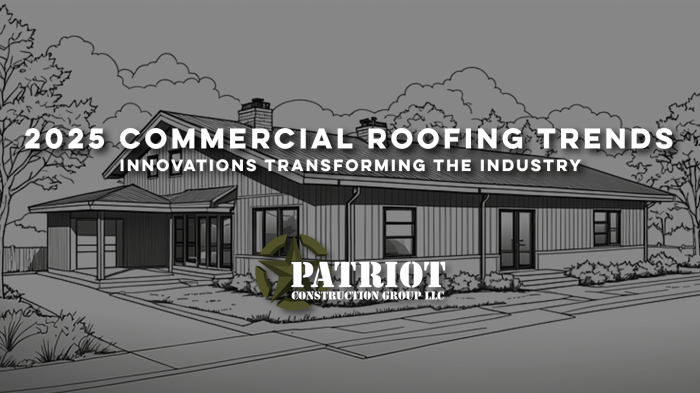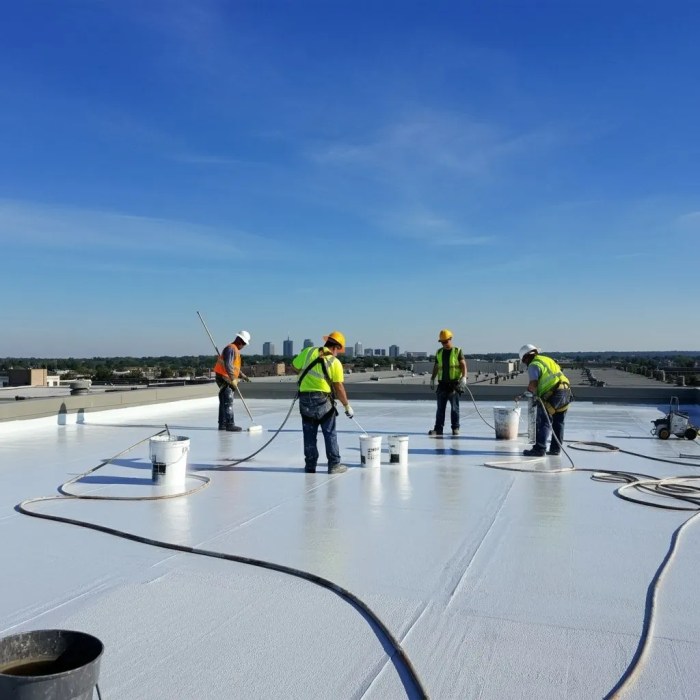
Exploring the landscape of Commercial Roofing Trends in 2025 Construction, this introduction sets the stage for an insightful discussion on the latest innovations and practices shaping the industry. From cutting-edge materials to sustainable solutions, this overview delves into the exciting developments that await in the upcoming years.
As we navigate through the advancements in construction technology and eco-friendly practices, the narrative unfolds to reveal a compelling glimpse into the future of commercial roofing.
Current Trends in Commercial Roofing
In the ever-evolving world of commercial roofing, there are several trends that are shaping the industry. From the materials being used to the incorporation of smart technology, the landscape of commercial roofing is changing rapidly.
Latest Materials in Commercial Roofing
Commercial roofing materials have come a long way in recent years, with a focus on durability, energy efficiency, and sustainability. Some of the latest materials being used include:
- Solar reflective coatings to reduce heat absorption
- Green roofs made of vegetation for improved insulation
- Single-ply membranes for easy installation and maintenance
Advancements in Sustainable Roofing Practices
Sustainability is a key focus in the construction industry, and commercial roofing is no exception. Advancements in sustainable roofing practices include:
- Recycled materials for reduced environmental impact
- Cool roofs to lower energy consumption
- Rainwater harvesting systems for water conservation
Incorporation of Smart Technology in Commercial Roofing Systems
The integration of smart technology in commercial roofing systems is revolutionizing the way roofs are monitored and maintained. Some of the advancements in this area include:
- Remote monitoring sensors for real-time data on roof condition
- Automated leak detection systems for early problem detection
- Smart thermostats for optimal energy efficiency
Future Forecast for 2025
Climate change is expected to have a significant impact on commercial roofing trends in 2025. With the increasing frequency and intensity of extreme weather events, commercial roofs will need to be more resilient and durable to withstand these conditions. This will lead to a shift towards more sustainable and weather-resistant roofing materials and technologies.
Impact of Climate Change on Commercial Roofing Trends
- Increased demand for impact-resistant roofing materials to withstand hailstorms and high winds.
- Growing use of cool roofs to reduce heat absorption and combat urban heat island effect.
- Rise in demand for waterproofing solutions to prevent leaks and damage from heavy rainfall.
Expected Growth of Green Roofing Solutions
Green roofing solutions are projected to experience significant growth in 2025 as more businesses prioritize sustainability and environmental responsibility. These eco-friendly roofs not only provide insulation and reduce energy costs but also contribute to biodiversity and improve air quality.
- Expansion of green roof installations in urban areas to promote green spaces and reduce carbon footprint.
- Increased adoption of solar roofing systems to harness renewable energy and enhance sustainability efforts.
- Implementation of vegetative roofs for stormwater management and to mitigate the effects of climate change.
Energy Efficiency Standards Shaping the Future of Commercial Roofing
Energy efficiency standards are playing a crucial role in shaping the future of commercial roofing by driving the adoption of energy-efficient materials and technologies. In 2025, commercial buildings will need to meet higher energy performance requirements, leading to the following trends:
- Integration of reflective roofing materials to reduce cooling costs and improve energy efficiency.
- Emphasis on proper insulation and air sealing to enhance thermal performance and minimize heat loss.
- Development of smart roofing systems that optimize energy usage and monitor roof conditions in real-time.
Technological Innovations in Commercial Roofing

The construction industry is continuously evolving with the integration of cutting-edge technologies to enhance efficiency, accuracy, and safety in commercial roofing projects. In this section, we will delve into the technological innovations that are reshaping the landscape of commercial roofing.
Use of Drones for Roof Inspections
Drones have revolutionized the way roof inspections are conducted in the construction industry. These unmanned aerial vehicles can capture high-resolution images and videos of roofs, providing a detailed view of the entire structure. By using drones for roof inspections, contractors can identify potential issues such as leaks, cracks, or damage without the need for manual inspection, saving time and resources.
Role of Artificial Intelligence in Optimizing Projects
Artificial intelligence (AI) is playing a crucial role in optimizing commercial roofing projects. AI algorithms can analyze vast amounts of data to predict maintenance needs, optimize energy efficiency, and improve overall project management. By leveraging AI technology, contractors can make informed decisions, reduce costs, and enhance the sustainability of commercial roofs.
Advancements in 3D Printing for Roofing Components
D printing technology has introduced new possibilities for creating customized roofing components with precision and efficiency. This innovative manufacturing process allows for the production of complex roof designs and structures that were previously challenging to achieve. By utilizing 3D printing for roofing components, contractors can streamline the construction process, reduce material waste, and improve the overall quality of commercial roofs.
Sustainable Practices and Eco-Friendly Materials

As the construction industry continues to prioritize sustainability, the use of eco-friendly materials in commercial roofing has become increasingly popular. These materials not only help reduce the environmental impact of buildings but also provide long-term benefits for property owners.
Comparison of Eco-Friendly Roofing Materials
- Recycled Shingles: Made from recycled materials such as plastic, rubber, or wood fibers, these shingles help reduce waste in landfills and can be just as durable as traditional shingles.
- Solar Panels: While not a roofing material in itself, solar panels integrated into commercial roofs can generate clean energy and reduce electricity costs for businesses.
- Green Roofs: These roofs are covered with vegetation, providing insulation, reducing energy costs, and improving air quality in urban areas.
Innovative Recycling Practices
- Roof Shingle Recycling: Companies are now recycling old asphalt shingles into pavement for roads, reducing the need for new materials and lowering carbon emissions.
- Metal Roof Recycling: Metal roofs can be recycled indefinitely without losing quality, making them a sustainable option for commercial buildings.
Importance of Sustainable Practices
Sustainable practices in the construction industry not only benefit the environment but also contribute to the overall health and well-being of occupants. By using eco-friendly materials and implementing recycling initiatives, companies can reduce their carbon footprint and create healthier spaces for employees and customers.
Final Thoughts

In conclusion, the journey through Commercial Roofing Trends in 2025 Construction unveils a tapestry of progress and sustainability. From smart technologies to eco-friendly materials, the industry is poised for a dynamic transformation in the years ahead.
FAQ Section
What are some examples of sustainable roofing materials?
Some examples of sustainable roofing materials include recycled shingles, solar panels, and green roofs that promote energy efficiency and environmental conservation.
How is climate change expected to influence commercial roofing trends in 2025?
Climate change is anticipated to drive the adoption of more resilient and weather-resistant roofing materials to withstand extreme weather conditions and minimize environmental impact.
What role does artificial intelligence play in optimizing commercial roofing projects?
Artificial intelligence is utilized to streamline project planning, assess roof conditions, and enhance maintenance strategies, ultimately improving efficiency and reducing costs in commercial roofing projects.












